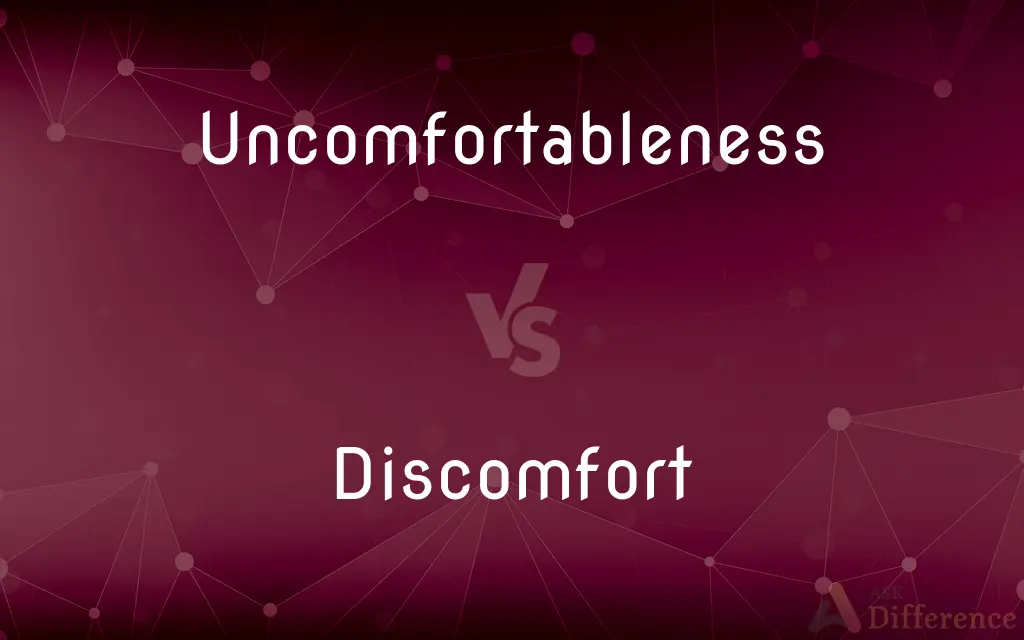Uncomfortableness vs. Discomfort — What's the Difference?
Edited by Tayyaba Rehman — By Urooj Arif — Updated on April 4, 2024
Uncomfortableness often refers to a psychological state of unease or awkwardness, while discomfort is a broader term that can denote both physical pain and minor psychological unease.

Difference Between Uncomfortableness and Discomfort
Table of Contents
ADVERTISEMENT
Key Differences
Uncomfortableness is primarily associated with feelings of psychological unease, such as awkwardness or embarrassment in social situations. It captures the essence of being out of one's comfort zone on an emotional or mental level. Discomfort, on the other hand, is a more encompassing term that can refer to both physical sensations of unease, like pain or itchiness, and psychological feelings similar to those described by uncomfortableness.
The experience of uncomfortableness is highly subjective and can vary greatly depending on the individual's personality, experiences, and current situation. It often arises in social contexts, such as during difficult conversations or in unfamiliar social settings. Discomfort, however, can be triggered by a wide range of situations, including physical conditions, environmental factors, and psychological circumstances, making it a more universally understood concept.
While uncomfortableness is often tied to specific scenarios or interactions that provoke a sense of social unease or awkwardness, discomfort might not always have a clear source and can be more diffuse, encompassing a general feeling of not being at ease. For example, sitting in an awkward position can cause physical discomfort, whereas feeling out of place at a social event might lead to uncomfortableness.
Addressing uncomfortableness often involves navigating or adjusting the social or psychological factors causing the unease. In contrast, alleviating discomfort may require addressing physical conditions or environmental adjustments, such as changing one's posture or reducing noise levels.
Both uncomfortableness and discomfort serve as signals that something in our environment or interactions is not aligning with our preferences or well-being. Recognizing and responding to these feelings can help improve our comfort and overall satisfaction in various situations.
ADVERTISEMENT
Comparison Chart
Primary Association
Psychological unease, such as awkwardness or embarrassment.
Both physical unease (pain, itchiness) and psychological feelings of unease.
Common Triggers
Social interactions, unfamiliar settings.
Physical conditions, environmental factors, psychological circumstances.
Response
Navigating or adjusting social or psychological factors.
Addressing physical conditions, making environmental adjustments.
Scope
Often specific to social or mental discomfort.
Broader, encompassing both physical and psychological aspects.
Nature
Highly subjective and varies greatly among individuals.
More universally understood and can have clear or diffuse sources.
Compare with Definitions
Uncomfortableness
Can be mitigated by familiarizing oneself with environments or people.
Rehearsing a speech can reduce uncomfortableness.
Discomfort
Psychological discomfort can stem from uncertainty or fear.
Watching a suspenseful movie can create a sense of discomfort.
Uncomfortableness
Often results from feeling out of place or embarrassed.
Forgetting someone's name can lead to feelings of uncomfortableness.
Discomfort
Can be caused by a variety of physical and emotional factors.
A noisy environment can lead to sensory discomfort.
Uncomfortableness
Tied to personal perceptions and experiences.
What causes uncomfortableness in one person may not affect another.
Discomfort
Discomfort refers to a mild state of physical or psychological unease.
Sitting for long periods can cause physical discomfort.
Uncomfortableness
It highlights a psychological state of not being at ease.
Unfamiliar social settings can increase a person's uncomfortableness.
Discomfort
Often more general and can be experienced by anyone.
Everyone experiences discomfort at some point, like wearing tight shoes.
Uncomfortableness
Uncomfortableness is feeling uneasy or awkward, especially in social situations.
Feeling uncomfortableness when speaking in public is common.
Discomfort
Physical discomfort can usually be alleviated by changing one's situation.
Adjusting the room temperature can relieve thermal discomfort.
Uncomfortableness
Experiencing physical discomfort.
Discomfort
Mental or bodily distress.
Uncomfortableness
Ill at ease; uneasy.
Discomfort
Something that disturbs one's comfort; an annoyance.
Uncomfortableness
Causing anxiety; disquieting.
Discomfort
To make uncomfortable; distress.
Uncomfortableness
Discomfort, especially uneasiness associated with awkwardness, embarrassment, or self-consciousness.
Discomfort
Mental or bodily distress.
Uncomfortableness
The state of being tense and feeling pain
Discomfort
Something that disturbs one’s comfort; an annoyance.
Uncomfortableness
Embarrassment deriving from the feeling that others are critically aware of you
Discomfort
To cause annoyance or distress to.
Discomfort
(obsolete) To discourage; to deject.
Discomfort
To discourage; to deject.
His funeral shall not be in our camp,Lest it discomfort us.
Discomfort
To destroy or disturb the comfort of; to deprive of quiet enjoyment; to make uneasy; to pain; as, a smoky chimney discomforts a family.
Discomfort
Discouragement.
Discomfort
Want of comfort; uneasiness, mental or physical; disturbance of peace; inquietude; pain; distress; sorrow.
Strive against all the discomforts of thy sufferings.
Discomfort
The state of being tense and feeling pain
Discomfort
An uncomfortable feeling in some part of the body
Common Curiosities
Can physical discomfort lead to uncomfortableness?
Yes, physical discomfort can sometimes cause psychological unease, thus leading to uncomfortableness, especially if it affects social interaction or self-perception.
What is uncomfortableness?
Uncomfortableness refers to a psychological state of feeling uneasy or awkward, often in social situations.
How does discomfort differ from uncomfortableness?
Discomfort is a broader term that includes both physical and psychological unease, while uncomfortableness specifically refers to psychological unease.
Is uncomfortableness always related to social situations?
While often related to social situations, uncomfortableness can also arise from personal conflicts or internal dilemmas.
Can discomfort be beneficial?
Yes, experiencing discomfort can be a sign of growth or adaptation, pushing individuals to address and overcome challenges.
How do personal experiences influence feelings of uncomfortableness?
Personal experiences shape how individuals perceive and react to situations, influencing what might cause uncomfortableness.
Why do people experience discomfort differently?
People’s thresholds and reactions to discomfort vary due to differences in physiology, experiences, and personal tolerance levels.
How can one manage feelings of discomfort?
Managing discomfort involves identifying the source of unease and making appropriate adjustments, whether they are physical or psychological.
Is it normal to feel discomfort in new environments?
Yes, feeling discomfort in new environments is a natural response to unfamiliarity and can diminish with time and adaptation.
Can discomfort be a symptom of a health issue?
Yes, physical discomfort can sometimes indicate underlying health issues and should be assessed if persistent.
How can mindfulness help with discomfort?
Mindfulness can help by increasing awareness of the body and mind, allowing individuals to respond to discomfort more effectively.
Is avoiding discomfort always beneficial?
Avoiding discomfort can sometimes prevent personal growth; facing and overcoming discomfort can lead to resilience.
Can changing one’s mindset reduce feelings of uncomfortableness?
Yes, adopting a more positive or open mindset can help mitigate feelings of uncomfortableness in challenging situations.
Can technology cause discomfort?
Yes, technology can cause physical discomfort, such as eye strain or poor posture, and psychological discomfort, such as information overload or social media-induced anxiety.
How can one build tolerance to discomfort?
Building tolerance to discomfort involves gradually exposing oneself to uncomfortable situations and learning coping strategies.
Share Your Discovery

Previous Comparison
Handwriting vs. Printing
Next Comparison
Euthanised vs. EuthanizedAuthor Spotlight
Written by
Urooj ArifUrooj is a skilled content writer at Ask Difference, known for her exceptional ability to simplify complex topics into engaging and informative content. With a passion for research and a flair for clear, concise writing, she consistently delivers articles that resonate with our diverse audience.
Edited by
Tayyaba RehmanTayyaba Rehman is a distinguished writer, currently serving as a primary contributor to askdifference.com. As a researcher in semantics and etymology, Tayyaba's passion for the complexity of languages and their distinctions has found a perfect home on the platform. Tayyaba delves into the intricacies of language, distinguishing between commonly confused words and phrases, thereby providing clarity for readers worldwide.















































